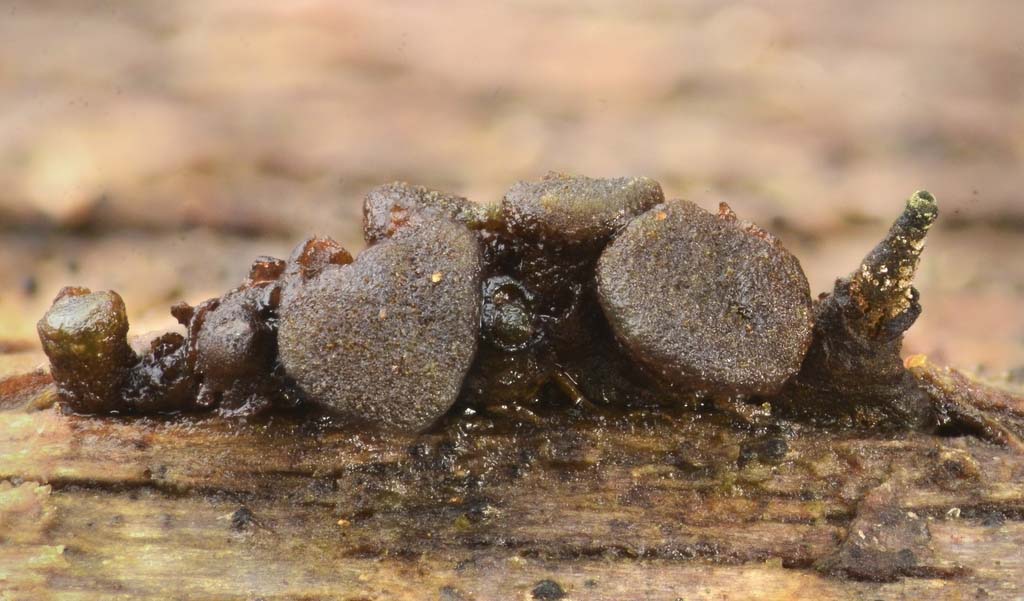
© Connor Dooley
Danny’s DNA Discoveries – Dermateaceae of the PNW
by Danny Miller
|
|
Danny’s DNA Discoveries – Dermateaceae of the PNW
|
|
Introduction
The Leotiomycetes are the inoperculate class of ascos, where the ascii do not have a lid, but instead have a pore at the top that the spores escape from. This is difficult to see without a quality microscope, but the species in the class are usually tiny cup fungi (maximum size <1cm across) growing on wood, as well as the earth tongues (club fungi with a differentiated head). In contrast, the Pezizomycetes contain true truffles, morels and false morels, the larger cup fungi, and tiny cups that do not grow on wood (although there are exceptions). Other classes of ascos exist as well with more cups, truffle-like fungi, and carbonaceous fungi. My ITS tree cannot show the orders holding together, but a 5-gene study and a 15-gene study confirm where I have placed these species. Dermateaceae in particular usually (but not always) erupt out of wood, looking somewhat embedded (like Tympanis in the Leotiales which are clusters of black erumpent cups, and like other species in other orders which erupt out of leaves or twigs). They may be black (Dermea) or colourful (ochre) (Pezicula) and are tiny (~1mm across). These are probably going to be split from the Helotiales into a separate order of the Leotiomycetes. A 5-gene study suggests they are near Medeolaria, which has its own order already, the Medeolariales. ITS only suggests they are not. However, the 15-gene study did not include Medeolaria and cannot confirm that we don't need to erect a new order for these, which if so could be called the Dermateales. abundant common uncommon rare - colour codes match my Pictorial Key and are my opinions and probably reflect my bias of living in W WA. Rare species may be locally common in certain places at certain times. |
|
Dermateaceae All of these need verifying that they have been placed in the correct genus and that the reports of them being here are true. We need type area collections and local collections of them all. They are probably other species here too. Dermea balsamea NY - Dermea cerasi EU - Dermea grovesii ON - Dermea libocedri CA - Dermea molliuscula PA - Dermea prunastri EU - the proper genus of this is unknown. Some say it belongs in Tympanis (but the microscopy doesn't seem to fit) and some say in Eutypella (which is in a different class, the Sordariomycetes). The microscopy and morphology suggest to me it's possible it really is in Dermea. We need collections. Dermea pseudotsugae BC - Dermea rhytidiformans BC - Dermea tetrasperma BC - Dermea populi ON (=Neofabraea populi?) - we need collections to see if this belongs in Dermea or Neofabraea. Pezicula corni ID - this species does not appear to be erumpent. Pezicula corylina ON - Pezicula ocellata EU - Pezicula pruinosa NH - Pezicula PNW01 - one Vancouver BC sequence. It may be one of the above species. Dermateaceae PNW01 - identified as a Pezicula, it seems to need a new genus. I think this is a sequence from OR. It may be one of the above species. Dermateaceae PNW02 - identified as a Pezicula, it seems to need the same new genus. I think this is a sequence from OR. It may be one of the above species. unsequenced possible Neodermea acerina © Connor Dooley (from OR)
'Podophacidium' PNW01 - these tiny whitish cups with yellow stellate margins on conifer wood have very low support for being in Podophacidium (close to a single UK sequence purporting to be in that genus with no proof) and even lower support for being in the Dermataceae, but I have to write this up somewhere. The observation has some microscopy. 'Podophacidium' PNW01 © Jordan Gates |